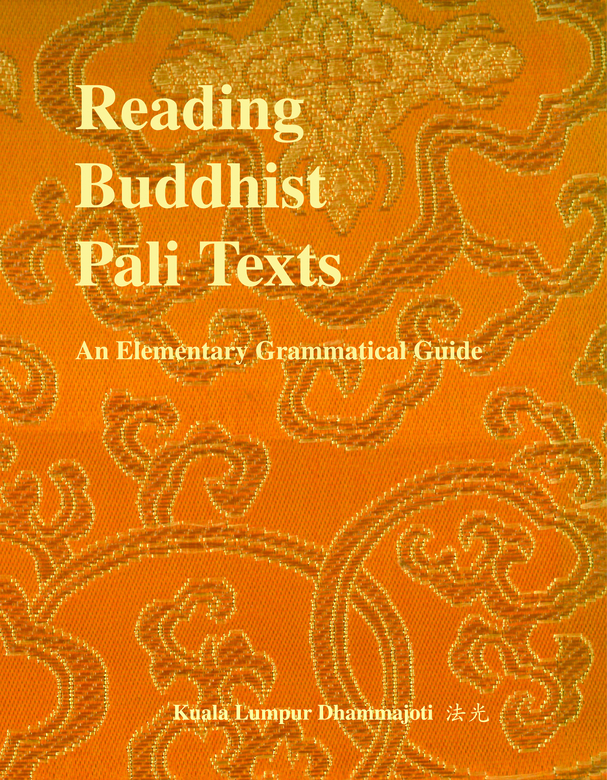Reading Buddhist Pāli Texts: An Elementary Grammatical Guide

Reading Buddhist Pāli Texts: An Elementary Grammatical Guide
Author: Venerable Professor K L Dhammajoti
Publisher: The Buddha-Dharma Centre of Hong Kong
(Hong Kong, March 2018). pp. 334++ ISBN: 978-988-16820-1-7
International Book Orders
At present we use Paypal to settle international book orders. Customers should advise on the title of the books required, the quantity, as well as the name and address of the recipients at publication@buddha-dharma.org.hk.
Local Book Orders
Interested local readers could also purchase the hardcopy of the books at The Buddha-Dharma Centre of Hong Kong.
Our official office hour is weekdays 10:00 – 6:00pm (lunch hour: 1:00 – 2:00pm). The office is closed on weekends and public holidays.
Contents
Preface
Abbreviations
Lesson 1
1.1 The Pali language and its alphabet
1.2 Phonological remarks
1.3 Nouns: masculine (m), neuter (n) and faminine (f)
1.4 Five out of eight cases: (I) nominative (nom); (II) accusative (acc); (IV) dative (dat); (VI) genitive (gen); (VII) locative (loc)
1.5 Adjectives
1.6 Indeclinables
1.7 Verbs
Lesson 2
2.1 Gen used for expressing “to have”
2.2 Three grades of root strength
2.3 Conjugational classes of verbs
2.4 Class I verbs
2.5 Class X verbs
2.6 The instrumental (ins), the ablative (abl), the vocative (voc)
2.7 Declensions of -ā ending (f) : paññā
2.8 Declensions of -i ending (m) : pati
2.9 More on adverbial usages
Lesson 3
3.1 Prefixes
3.2 Class VI verbs
3.3 Class IV verbs
3.4 Declensions of -u ending (m) : bhikkhu
3.5 Declensions of -u ending (n) : cakkhu
3.6 Declensions of -u ending (f) : dhenu
3.7 Declensions of -i ending (f) : jāti
3.8 Declensions of -i ending (n) : akkhi
3.9 Declensions of -ī ending (f) : nadī
3.10 Causatives
Lesson 4
4.1 Denominatives
4.2 Class II verbs
4.3 Declension of consonant-ending nouns: bhagavant (m) and bhavant (m)
4.4 Possessive suffixies -vant and -mant
4.5 Gerund
4.6 Possessive suffix -in, -vin
4.7 Past Participle Passive (PPP)
Lesson 5
5.1 Declension of -an ending nouns: attan (m), rājan (m), brahman (m), san (m), kamman (n)
5.2 Declension of demonstrative pronouns: ayaṃ (m, f), idaṃ/imaṃ (n)
5.3 Declension of personal pronouns: ahaṃ, tvaṃ, so (m), taṃ (n), sā (f)
5.4 Declension of demonstrative pronoun: etad ‘this’, asau ‘that’
5.5 Pronouns as substantives and as adjectives
5.6 Pronominal adjectives
5.7 Class V verbs
5.8 Class VIII verbs
Lesson 6
6.1 Declension of -as and -us ending nouns
6.2 Class IX verbs
6.3 Present Participles (PrP)
6.4 Relative pronouns and relative clauses
Lesson 7
7.1 Future tense
7.2 Interrogative pronouns kad
7.3 Interrogation and interrogative clauses
7.4 The optative mode (opt)
Lesson 8
8.1 Future Passive Participles (FPP)
8.2 Class III verbs
8.3 Numerals (cardinal)
Lesson 9
9.1 Locative and genitive absolute (loc abs, gen abs)
9.2 Imperative mood (ipv)
9.3 Attanopada verb forms (āt)
9.4 Passive voice (pas)
Lesson 10
10.1 Aorists
10.2 Class VII verbs
Lesson 11
11.1 Infinitive (inf)
11.2 Declension of -ū ending m and f nouns
11.3 Suffixes and nominal derivation
Lesson 12
12.1 Some irregular declensions: sakhi (m) and go (m)
12.2 Nominal Compounds (samāsa): dvanda, tappurisa, avyayībhāva, kammadhāraya, digu
12.3 The Perfect Tense (pf)
12.4 Agent nouns (ag noun)
12.5 Periphrastic future (peri fut)
Lesson 13
13.1 Ordinal numerals
13.2 Nouns and adj compounded with -kṛ and -bhū
13.3 Bahubbīhi-samāsa
13.4 Prohibitive (proh)
Lesson 14
14.1 Bahubbīhi formed with -kāma as the last member
14.2 Adverbial suffix: -tra, -thā, -dā, -dhā, -to, -so
14.3 Past Participle Active (PPA)
14.4 Conditional tense (condl)
14.5 Desiderative (desid)
Appendix: Declension and conjugation tables
Useful References
Glossary
